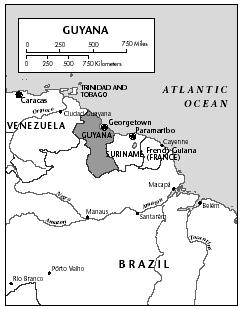Guyana - Political background
Guyana was the first country in the New World to be explored by non-Iberians. It was originally divided into three Dutch colonies: Essequibo, Demerara, and Berbice. Following a war between Britain and the Netherlands in 1803, the British captured the colonies, which were ceded to them by the Dutch 11 years later. The three colonies were united to form the colony of British Guyana in 1831. That colony remained under British control until 26 May 1966, when Guyana gained its independence.
In 1980, the Guyanese government adopted a Constitution that established the country as a cooperative republic within the Commonwealth. Under this new Constitution, the president is the head of state and is elected for a five-year term on the basis of parliamentary elections. The prime minister is the head of government and leader of the majority party in the National Assembly. The National Assembly has 68 members, 65 of whom are elected by a system of proportional representation, with each voter casting his vote in favor of a list rather than a specific candidate. The president appoints a leader of the opposition from among opposition members of the assembly.
Guyana has two major political parties. The People's Progressive Party/Civic (PPP/C) is a socialist party led by Bharrat Jagdeo. The People's National Congress (PNC) is a socialist/populist party, headed by Hugh Desmond Hoyte. There are also four minor parties: Alliance for Guyana (AFG, led by Rupert Roopnaraine and incorporating the Guyana Labour Party and the Working People's Alliance); Guyana Action Party (GAP, led by Paul Hardy); The United Force (TUF, led by Manzoor Nadir); and Rise, Organize, and Rebuild (ROAR, led by Ravi DEV).
The PPP/C was launched on 1 January 1950, with Cheddi Jagan as its leader, Linden Burnham as its chairman, and Janet Jagan as its secretary. In 1953, the first general elections under adult suffrage were held. The PPP/C won 18 of the 24 seats in the Parliament. However the PPP/C faced a hurdle when, in 1955, Burnham and his supporters split the party. The major reason for this was that Burnham wanted to be leader of the PPP/C. In 1957, he launched his own party, the PNC, but was defeated in the general elections which were held that year. The PPP/C continued to be victorious in the general elections of 1961 and 1964.
Corruption, violence, and fraud marred the electoral system after 1964. The PPP/C lost the 1968 election to the PNC—who captured 56% of the vote. In the elections of 1973, 1980, and 1985, the PPP/C and the WPA accused the PNC of electoral fraud and corruption. The popular and charismatic leader of the WPA, Walter Rodney, was allegedly assassinated in 1980 for his opposition to the policies of the PNC.
In October 1992, free and fair elections were held. The PPP/C emerged victorious, having received 54% of the vote. Cheddi Jagan was once again reinstated as president. However, the PPP/C suffered a great loss when he died five years later. In the 1997 general elections, Janet Jagan, widow of the former president, led the PPP/C to victory once again— capturing 29 of the 53 elected seats in the House of Assembly. Her government included Sam Hinds as prime minister and Bharrat Jagdeo as vice president. Health problems forced Jagan's resignation. On 11 August 1999, Jagdeo was sworn in as the sixth president of the Republic of Guyana. He was sworn in for a second term on 31 March 2001.

Comment about this article, ask questions, or add new information about this topic: